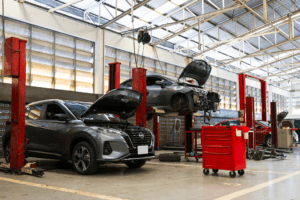Is Scaffolding Insurance Essential for Your Construction Business?

When you’re running a construction business, the question of whether scaffolding insurance is essential might have crossed your mind. With potential accidents lurking on every project, you can’t afford to overlook the risks associated with scaffolding work. This insurance not only shields your business from financial disaster but also showcases your dedication to safety and regulatory compliance. However, deciding if it’s a necessity for your specific operations isn’t always straightforward. Are you sure you’ve considered all the factors that could impact your decision? Let’s explore what you should weigh before making that vital choice.
Key Takeaways
– Scaffolding insurance protects against financial burdens from accidents, minimizing potential losses.
– It enhances company reputation by demonstrating a commitment to workplace safety.
– Coverage ensures compliance with safety regulations, reducing accident and liability risks.
– Insurance provides peace of mind, allowing focus on timely project completion.
– Bundled policies offer comprehensive protection and can reduce overall insurance costs.
Understanding Scaffolding Risks
Scaffolding risks are a critical concern for construction businesses, with frequent accidents highlighting the need for thorough safety measures. As a construction professional, you recognize that scaffolding accidents can lead to severe injuries or even fatalities, impacting both your workforce and your project’s timeline.
It’s crucial to understand that these risks arise from various factors, including structural failures, improper assembly, and inadequate training. To mitigate these hazards, you must adhere to stringent safety regulations and guarantee your team is well-versed in industry best practices.
To effectively manage scaffolding risks, start by implementing extensive safety training programs. These programs should cover proper assembly and disassembly techniques, load capacities, and emergency procedures.
Regular inspections of scaffolding structures should also be a part of your routine to identify potential weaknesses before they cause accidents. Compliance with safety regulations isn’t just a legal obligation; it’s a proactive step towards safeguarding your team and projects.
Incorporating these measures can greatly reduce the likelihood of scaffolding accidents. By prioritizing safety, you’re not only protecting your workforce but also enhancing your company’s reputation for reliability and professionalism in the construction industry.
Benefits of Scaffolding Insurance
While understanding the risks of scaffolding is essential, having scaffolding insurance is equally important for a construction business. This type of insurance serves as a safety net, offering critical protection for your company. It guarantees that you’re prepared for unforeseen accidents, safeguarding both your project and your reputation.
Let’s explore the benefits of scaffolding insurance:
Scaffolding Safety: Insurance encourages rigorous safety standards. By having coverage, you’re more likely to adhere to best practices, reducing the chance of accidents. This not only protects your workers but also minimizes downtime due to safety violations.
Liability Protection: Accidents can happen despite taking precautions. With scaffolding insurance, you’re shielded from the financial burden of potential lawsuits and claims. This protection covers damages, legal fees, and settlements, keeping your business financially secure.
Peace of Mind: Knowing you’re covered allows you to focus on what you do best—building. With scaffolding insurance, you have the confidence that your business is protected against unforeseen incidents, allowing you to concentrate on project delivery without worry.
Types of Coverage Available
When you’re maneuvering the complexities of scaffolding insurance, understanding the types of coverage available is essential. Scaffolding liability insurance is a cornerstone, safeguarding you against potential claims related to injuries or damages occurring on-site. This type of policy is particularly important given the inherent risks in construction work where scaffolding is involved.
Without it, you could face costly legal battles and significant financial loss.
Beyond liability, consider additional coverage options tailored to your specific needs. Equipment coverage protects your investment in scaffolding materials from theft or damage, ensuring that unexpected incidents don’t halt your project.
Workers’ compensation is another critical aspect, covering medical expenses and lost wages for employees injured on the job, thereby promoting a safer work environment.
Think about business interruption insurance. It can be a lifeline if your operations are disrupted due to unforeseen events, helping you maintain financial stability.
Evaluate bundled policies that combine multiple coverage options to maximize protection while potentially reducing costs.
Evaluating Your Business Needs
As you explore the various coverage options, identifying your specific business needs becomes an essential step in ensuring thorough protection.
Conducting a detailed business evaluation and risk assessment helps you pinpoint the unique challenges your construction business faces. Recognizing these factors allows you to tailor your scaffolding insurance to effectively shield against potential pitfalls.
To evaluate your business needs, consider the following:
Project Scope and Scale: Determine the size and complexity of your projects. Larger, more intricate projects typically carry higher risks, necessitating broader coverage options.
Workforce and Equipment: Evaluate the size of your workforce and the types of equipment used. A larger workforce and specialized machinery may require additional coverage to address specific liabilities.
Location and Environment: Assess the geographical areas where your projects occur. Different regions may present distinct risks, such as extreme weather conditions or local regulatory requirements, affecting your insurance needs.
Cost Factors to Consider
Understanding the cost factors in scaffolding insurance requires a keen eye for detail and a proactive approach to risk management. You need to evaluate several essential elements that can impact your insurance premiums.
One significant factor is the condition and frequency of scaffolding maintenance. Regular maintenance not only enhances safety but also reduces the likelihood of accidents, potentially lowering your insurance costs. Insurance providers often assess how well-maintained your scaffolding is when determining rates. Keeping detailed records of inspections and repairs shows your commitment to risk management.
Another vital element is the specific risks associated with your construction projects. High-risk projects, such as those involving significant heights or challenging environments, may result in higher premiums. You should thoroughly analyze these risks and implement effective safety protocols to mitigate potential hazards. This proactive stance can demonstrate to insurers that you’re serious about minimizing risks, which might help in negotiating better terms.
Additionally, evaluate the geographical location of your projects. Areas prone to natural disasters or extreme weather may influence insurance costs.
Choosing the Right Policy
Selecting the right scaffolding insurance policy demands a strategic approach, guaranteeing you align coverage with the specific needs of your construction business.
Start by conducting a thorough policy comparison to identify what various insurers offer. Don’t just go for the cheapest option; focus on the balance between cost and coverage. Recognize the unique risks your business faces and make sure the policy you choose addresses them thoroughly.
Consider these three essential steps:
Assess Coverage Limits: Verify the policy provides adequate coverage limits. Scaffolding accidents can result in significant financial liabilities. Your policy should cover potential damages and legal expenses without leaving gaps.
Evaluate Exclusions and Endorsements: Policies often come with exclusions that can leave you vulnerable. Understand these limitations and consider endorsements that can extend your coverage to include specific risks relevant to your projects.
Review Insurer Reputation: Investigate the insurer’s track record in handling claims efficiently. A responsive and fair claims process is vital when a mishap occurs.
Frequently Asked Questions
How Can I File a Claim for Scaffolding Insurance?
To file a scaffolding insurance claim, gather your insurance documentation first. Contact your insurer promptly to initiate the claim process. Clearly describe the incident, provide necessary details, and guarantee all paperwork is complete to streamline the process.
Are There Specific Legal Requirements for Scaffolding Insurance?
You must understand your legal obligations for scaffolding insurance. Compliance guarantees protection against potential liabilities. Consult local regulations to avoid penalties. Secure adequate coverage to mitigate risks and maintain safety standards. It’s vital for your construction business’s success.
What Happens if I Don’t Have Scaffolding Insurance?
What if an accident occurs without scaffolding insurance? You’d face significant financial risks and liability concerns. Protect your business by securing coverage, ensuring you’re prepared for unforeseen incidents and safeguarding against potential lawsuits and hefty expenses.
Can Scaffolding Insurance Cover Equipment Theft?
Scaffolding insurance can indeed cover equipment theft, providing essential equipment protection. By investing in such a policy, you’re adopting a risk-focused approach that enhances theft prevention, ensuring your construction business remains resilient against unexpected losses.
How Do I Find a Reputable Scaffolding Insurance Provider?
Over 60% of construction businesses face significant financial losses annually. To find reputable insurance providers, research online reviews, compare coverage options, and consult industry peers. Your choice can mitigate risks and safeguard your scaffolding operations effectively.
Conclusion
Don’t underestimate the importance of scaffolding insurance for your construction business. Sure, you might think accidents won’t happen to you, but ignoring the risks can lead to significant financial and legal troubles. By securing the right coverage, you’re not just protecting your assets; you’re also demonstrating a commitment to safety and compliance. Evaluate your specific needs, consider the costs, and choose a policy that guarantees peace of mind. It’s a smart decision that safeguards your future and reputation.



